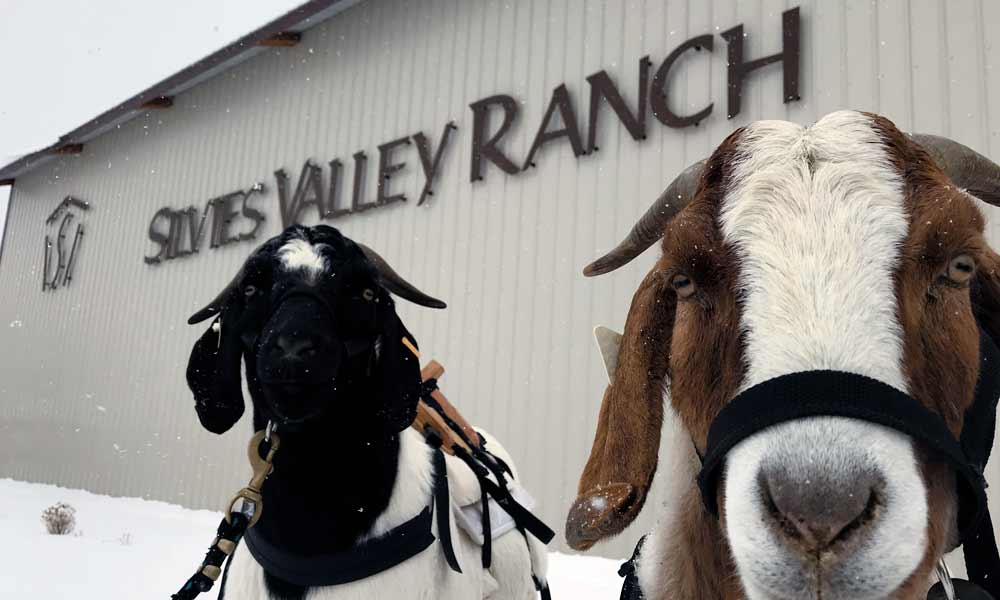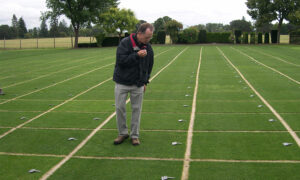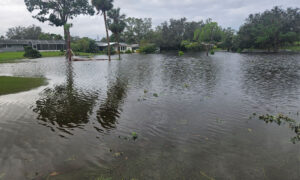The title of this article – a take-off on the expression “No guts, no glory” – is on a T-shirt I bought at Silvies Valley Ranch this June. The phrase is apropos in several ways: the magnificent 140,000-acre property in remote Eastern Oregon is a working ranch that also boasts one of the most daring, outside-the-box golf courses I’ve seen or played during my three decades as a golf writer.
It even has goats for caddies, though there’s no guarantee these beasts will bring you glory.
Designed by Portland architect Dan Hixson, the layout is reversible. One day it plays in one direction as the Craddock course, and the next day the first tee on Hankins starts at the former’s 18th tee and winds the opposite way. The experience is mind-boggling. Some of the holes played clockwise are unrecognizable when played counterclockwise thanks to 27 separate greens and Hixson’s wily placement of 102 tees (color-coded signage to navigate the courses is excellent, by the way). Each course extends over 7,000 yards. But their length is mitigated by being nearly a mile above sea level, making these the highest golf courses in the state.
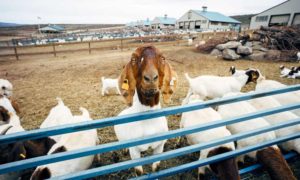 Due to his early start at Silvies Valley Ranch, Hixson could have pre-empted Tom Doak and his acclaimed, reversible Loop at Forest Dunes in Michigan, which debuted in 2016. But, because of a brief five-month growing season, it took Hixson eight years to finish the project and Craddock/Hankins opened in late-summer 2017.
Due to his early start at Silvies Valley Ranch, Hixson could have pre-empted Tom Doak and his acclaimed, reversible Loop at Forest Dunes in Michigan, which debuted in 2016. But, because of a brief five-month growing season, it took Hixson eight years to finish the project and Craddock/Hankins opened in late-summer 2017.
“The design features were always evolving and done ‘in-field’ during construction,” said Hixson, a former PGA head professional who began dreaming of becoming a golf course architect as a youngster. His other new courses include Wine Valley near Walla Walla, Wash., and Bandon (Oregon) Crossings. “But the routing only changed a little, with one green location moved after the initial plan was drawn. The construction season is pretty short at 4,800 feet above sea level, and the seeding and grow-in period is much shorter still.”
The site was both challenging to design and get to for Hixson, who made a whopping 110 trips (six hours each way) to it from his Rose City home. But the effort was worthwhile as the course’s unique configuration makes economic and ecological sense. Superintendent Sean Hoolehan, a former president of the GCSAA, has a relatively small crew for such a big operation, stemming partly from a shallow local employee pool. Maintenance staffing requirements for two 18s would have been much costlier and harder to sustain. Hixson also crafted an irrigation-efficient layout, one planted with three types of grasses that require little or no pesticides and other chemicals. Pest control is aided by 5,000 birdhouses, where mosquito-devouring blue birds and bats have taken up residence.
Meanwhile, Hixson’s offering is an entertaining and exhilarating excursion. “I want people to really love it,” Hixson said of Silvies’ reversible 18. “If golf isn’t fun, it really is nothing.”
He added: “I designed it for golfers, so they would come to a rural part of our state to have fun playing a course unlike anything they have ever seen.”
The Ranch is akin to such far-flung places as Sand Valley in Wisconsin, Nebraska’s Sand Hills courses, and Streamsong in Florida, all of which boast Doak-designed courses. But Silvies’ resort is a different animal, and it’s even more off the beaten track, lying over three hours by car from the “biggest” nearby cities of Bend, Ore., and Boise, Idaho. The closest towns, each about 45 miles away, are Burns and John Day, which have populations of 2,800 and 1,700.
The Ranch is owned by Dr. Scott Campbell and his wife, Sandy, two natives of the rural Beaver State towns of Burns and Alfalfa, respectively. The Campbells met while walking Miller Park on the south end of the property while each was on summer break from Oregon State University.
From that modest start the two went on to accomplish great things. As Scott explains: “She became a nurse and specialized initially in geriatric nursing and, eventually, quality assurance in the medical industry. I went to veterinary school. After we both graduated, we went to Portland and I bought a small animal practice. She quit nursing and put a quality-assurance program in our veterinary hospital. We believe it was the first veterinary quality-assurance program anywhere. We went on to build that business into the largest veterinary practice in the world.”
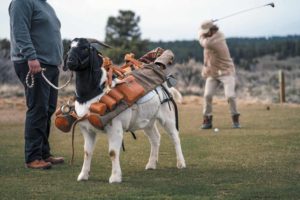
They grew that practice, Banfield Pet Hospital, into 725 clinics throughout the U.S., Mexico and the U.K. It was sold in 2007 by the Campbells and is now located within hundreds of PetSmart stores.
Also involved in the ownership group is another couple with deep Eastern Oregon roots, Robb and Lisa Foster. Robb is the Ranch manager and oversees all the non-golf construction, maintenance, roads, water and farming operations. Lisa helps out in reservations, bartending, the gift shop and occasionally drives a drink cart.
The Campbells and Fosters returned the property’s name to Silvies Valley Ranch, and began a massive restoration of native wetlands, riparian areas, forests, streams and meadows. Goats were introduced to better utilize forage, help with ecological projects and control invasive weeds. And they also started work on a high-end golf resort.
“The (lumber) mills closed a long time ago and no other industry came in,” Dr. Campbell said of his transformation of the Ranch. “I graduated from Burns High School in 1975 and there were 140 to 150 kids in my class. There were only 40 in last year’s graduation. What can we do for the community?” he pondered. “We’re trying to bring destination tourism to this part of Oregon, a lot like Bandon (on the southwest Oregon coast). There was nothing in Bandon before the golf courses.”
Millions of years ago the valley was home to early species of horses, bison, an occasional giant moose and wooly mammoths. Dr. Campbell notes that at around 15,000 B.C., during the last Ice Age, Native Americans used the site as an open corridor for southbound travel. In 1826, Peter Skene Ogden, a Canadian explorer and fur trader, “discovered” the valley and named it after one of his men, Captain Antonine Sylvaille. Silvies Valley Ranch got its name through a long-ago misspelling of Sylvaille.
Gradually inhabited by lumber- and dairymen, miners and goat ranchers (Craddock and Hankins were two early settlers), with a U.S. Post Office established in 1892 (now part of the current Ranch) and a railroad route opening in 1929, the property was converted into a Japanese internment camp in 1942. Several different owners had the land over the ensuing years, each failing and selling. In 1990, a California investor bought it to create a dude ranch. That effort also went under and, for the next 17 years, the massive parcel was leased, causing an overharvesting of trees. A privately-owned herd of wild horses also did significant environmental damage.
The Campbells are diligently restoring the Ranch’s natural splendor. “We have conducted many scientific studies at Silvies Valley Ranch since we have owned it, mostly in conjunction with Oregon State University but also with other universities such as Duke and Montana State,” said Scott. “One of my interests is in the water cycle and what happens to water once it hits the ground.”
While I was there a group of scientists from around the world reviewed the water system now used at Silvies Valley Ranch. “The scientists that were here were interested in some of the unique water-storage projects we have engineered at the Ranch,” he added. “They also studied our theories on the water cycle and how to improve the watershed and the environment.”
Of the 60-plus square miles of deeded property, there are now 6,000 acres of mountain meadows, 14,000 acres of Ponderosa pine forest, 20 miles of the Silvies River, over 20 named creeks and drainages, cattle and horses, as well as native Rocky Mountain elk, mule deer, pronghorn antelope, sage hens, grouse, pine martins, quail, black bear, cougar, coyotes, bobcats, badgers, squirrels, chipmunks, porcupines, beaver, raccoons, river otters, hawks, eagles, pigmy rabbits, wild turkeys, cranes, geese, ducks, song birds, woodpeckers, bass, catfish, perch and native redband trout.
In addition to the reversible course, Hixson designed an entertaining par-3 nine (named Chief Egan after an 1800s’ Paiute tribal leader in what then called “Oregon Country”) and the seven-hole MacVeigh’s Gauntlet (named after another early pioneer). Called “an extreme golf experience,” the latter employs Ranch goats for caddies. Special saddles were specially made by Portland-based Seamus Golf to carry clubs, beverage cans and the goat-caddies’ preferred payment, peanuts.
The golf-accessory company had never constructed such a contraption. After being contacted by Dr. Campbell, Seamus Golf co-founder Akbar Chisti spent 30 hours on the prototype. He then tried it out on his large goldendoodle. But the goats are 250-pound animals, and the saddle had to be retooled to fit them.
“It was way too small,” Chisti told CNN reporter Zahid Mahmood of his first goat-caddie saddle. “We know how the human body moves, we know how it needs to balance, but the goat was different.” There was also another key consideration. “Goats are notorious for dropping their waste. And when you’re trying to putt on the grass it can be a challenging obstruction. So we had to re-tilt the bag to accommodate that.”
Unlike Bandon Dunes, the Ranch is not intended to draw hundreds of golfers a week. “I don’t want more than 50 people a day to play the course,” Dr. Campbell asserted. The main income-generating component will be 200 luxury home sites proposed for the hills above Silvies Valley’s golf courses and resort amenities.
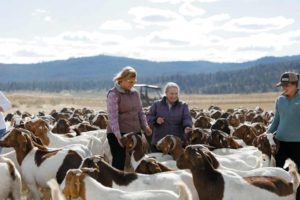
A two-in-one course concept is “not a good financial model,” admitted Hank Hickox, a Silvies advisor and Bandon Dunes’ first general manager. “It’s for people who are well-traveled and looking for something different. Silvies has a working ranch appeal. We don’t need a lot (of houses), just a few, and not on the course (but) with great views of the valley.”
The resort held its first noteworthy tournament – the Pacific Northwest Golf Association’s Master-40 Amateur – a week after my visit. The winner was Darren Kuhn of Pocatello, Idaho, who beat Jeff Byrnes of Buckley, Wash., 4 & 3 in the championship match. The responses by the field’s 60 players to the Hankins-Craddock set-up were overwhelmingly positive. “They loved the course,” said Tom Cade, PNGA Communications Director. According to Cade, yet another response was, “Boy this place is remote!”
Other guest features include beautiful, artfully-decorated cabins with all the modern frills (such as three flat-screen TVs and a hot tub), a lodge, spa, working cattle and goat operations, a 5,000-foot runway for private aircraft, two dining options, and non-golf activities such as fly-fishing, skeet shooting, hiking and ATV excursions.
It must be noted that the food menus (the closest nearby restaurant is in Burns) do not cater to vegetarians or all palates, though the chef will accommodate guests’ requests. The daily seven-course dinner – the only current option and locally sourced – consists of Ranch-raised beef, chevon (goat meat) and vegetable dishes. Don’t expect to find chicken or fish here.
The Ranch is decidedly a family affair. You’ll often find Scott and Sandy, who reside on the Ranch, in the lodge restaurant mingling with guests.
“Both of our sons, Tygh and Rand, were quite active in our veterinary practice,” said Scott. “Tygh and his fianceé Courtney live on the Ranch. Tygh is in charge of real estate and irrigation and Courtney is in charge of the new spa. Rand has one more year of law school at Willamette University (Oregon), is interested in natural resources law and has a girlfriend named Heather who he’s been friends with since third grade.
“My brother, Jeff, is one of our hosts,” Scott adds. “He also grew up in the area and has a PhD from Stanford University in immunology. He worked for companies such as Genentech. But his real love is baking bread and brewing beer! My sister, Kathy Jo, is also at the Ranch and helps take care of the goats. My brother-in-law, Ted, was her partner in the Ford and Polaris dealership in Burns, which is why we only have Fords and Polarises on the Ranch.
“Sandy’s sister, Sheryll, is responsible for all the permitting that we have to do and helps with the goats,” Dr. Campbell continued. “Sandy, Tygh and Rand are all very artistic. Tygh makes much of the metalwork, Rand does all the landscaping, and Sandy is the interior decorator. My parents have passed away, but my dad was the town doctor in Burns for many years and delivered some of our employees who now work on the Ranch.”
If you ever make it out to this remote outpost in east-central Oregon, expect a warm greeting from the Campbell clan. They’re here to stay, and so is an exceptional experience at one of the most revolutionary golf courses and self-contained resorts to debut in recent memory.
For more information, visit http://silvies.us/.
Jeff Shelley has written and published nine books as well as numerous articles for print and online media over the past 30 years. The Seattle resident is the co-founder of the Northwest Golf Media Association and board president of First Green, an international, nonprofit program that provides environmental and STEM education outreach using golf courses as environmental learning labs. jeff@fairgreenspublishing.com

